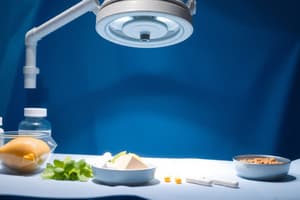Podcast
Questions and Answers
What is the primary characteristic of the enteral route of medication administration compared to parenteral?
What is the primary characteristic of the enteral route of medication administration compared to parenteral?
- Faster absorption
- Greater bioavailability
- More invasive
- Slower absorption (correct)
Which enteral route involves placing medication between the cheek and gum?
Which enteral route involves placing medication between the cheek and gum?
- Oral
- Sublingual
- Buccal (correct)
- Rectal
What is a key disadvantage of the enteral route of medication administration?
What is a key disadvantage of the enteral route of medication administration?
- Slower onset of action (correct)
- Rapid onset of action
- Suitable for unconscious patients
- High bioavailability
Where does first-pass metabolism primarily occur after enteral absorption?
Where does first-pass metabolism primarily occur after enteral absorption?
What is the purpose of enteric coating on medications?
What is the purpose of enteric coating on medications?
Which of the following is a sublingual medication used in EMS?
Which of the following is a sublingual medication used in EMS?
For which condition is buccal glucose gel typically used?
For which condition is buccal glucose gel typically used?
Why is it important to flush feeding tubes with water before and after medication administration?
Why is it important to flush feeding tubes with water before and after medication administration?
Which 'Right' of medication administration involves verifying the patient's identity?
Which 'Right' of medication administration involves verifying the patient's identity?
How many times should the medication label be checked before administration, according to the 'Rights'?
How many times should the medication label be checked before administration, according to the 'Rights'?
What action should be taken if a patient refuses medication?
What action should be taken if a patient refuses medication?
Why does sublingual nitroglycerin have a faster onset of action compared to oral tablets?
Why does sublingual nitroglycerin have a faster onset of action compared to oral tablets?
Which of the following is an advantage of enteral medication administration?
Which of the following is an advantage of enteral medication administration?
What is a potential disadvantage of first-pass metabolism?
What is a potential disadvantage of first-pass metabolism?
According to Clark's Rule, what factor is used to calculate a child's dose of medication?
According to Clark's Rule, what factor is used to calculate a child's dose of medication?
Why might a geriatric patient require a dose adjustment for enteral medications?
Why might a geriatric patient require a dose adjustment for enteral medications?
In which scenario is rectal administration favored over oral administration?
In which scenario is rectal administration favored over oral administration?
Why should enteric-coated tablets not be crushed?
Why should enteric-coated tablets not be crushed?
What is the potential risk of crushing extended-release medications?
What is the potential risk of crushing extended-release medications?
If a patient has difficulty swallowing a medication, what alternative formulations might be explored?
If a patient has difficulty swallowing a medication, what alternative formulations might be explored?
Flashcards
Enteral Route
Enteral Route
Medication administration via the gastrointestinal (GI) tract.
Oral (PO)
Oral (PO)
Swallowed and absorbed in the GI tract.
Buccal
Buccal
Placed between the cheek and gum for absorption via mucous membranes.
Sublingual (SL)
Sublingual (SL)
Signup and view all the flashcards
Rectal (PR)
Rectal (PR)
Signup and view all the flashcards
Orogastric/Nasogastric (OG/NG) Tube
Orogastric/Nasogastric (OG/NG) Tube
Signup and view all the flashcards
First-Pass Metabolism
First-Pass Metabolism
Signup and view all the flashcards
Enteric-Coated (EC)
Enteric-Coated (EC)
Signup and view all the flashcards
Extended-Release (ER, XR, SR)
Extended-Release (ER, XR, SR)
Signup and view all the flashcards
Nitroglycerin (NTG) SL
Nitroglycerin (NTG) SL
Signup and view all the flashcards
Glucose Gel Buccal
Glucose Gel Buccal
Signup and view all the flashcards
Right Patient
Right Patient
Signup and view all the flashcards
Right Time
Right Time
Signup and view all the flashcards
Right Medication
Right Medication
Signup and view all the flashcards
Liquid Meds
Liquid Meds
Signup and view all the flashcards
Clark's Rule
Clark's Rule
Signup and view all the flashcards
Enteric-Coated Medications
Enteric-Coated Medications
Signup and view all the flashcards
Extended-Release Medications
Extended-Release Medications
Signup and view all the flashcards
Pediatric Weight
Pediatric Weight
Signup and view all the flashcards
First-pass metabolism
First-pass metabolism
Signup and view all the flashcards
Study Notes
- The enteral route is a method of administering medications through the gastrointestinal (GI) tract
- It is a less invasive and slower method than parenteral administration
- It is an essential component of prehospital pharmacology
Key Enteral Routes in EMS
- Oral (PO) administration involves swallowing a medication for absorption in the GI tract.
- Buccal administration involves placing a medication between the cheek and gum, where it is absorbed through mucous membranes.
- Sublingual (SL) administration involves placing a medication under the tongue for rapid absorption.
- Rectal (PR) administration is used when oral administration is not feasible
- Orogastric/Nasogastric (OG/NG) Tube administration is for patients with enteral tubes for direct gastric delivery
Advantages of Enteral Administration
- Non-invasive and convenient
- Lower risk of infection
- Suitable for self-administration
Disadvantages of Enteral Administration
- Slower onset of action
- Absorption can be affected by food, gastric pH, or motility
- First-pass metabolism in the liver reduces bioavailability
- Not suitable for unconscious or vomiting patients
Pharmacokinetics of Enteral Medications
- GI pH and enzymes affect drug solubility
- Some drugs require an empty stomach for optimal absorption
- The small intestine has the largest surface area for absorption
First-Pass Metabolism
- Medications absorbed through the GI tract enter the hepatic portal system, where the liver metabolizes them before reaching systemic circulation
- This reduces drug bioavailability compared to intravenous administration
Enteric-Coated and Extended-Release Medications
- Enteric-coated (EC) drugs protect against stomach acid and dissolve in the intestines
- Extended-release (ER, XR, SR) drugs provide prolonged therapeutic effects
- Do not crush or split enteric-coated or extended-release medications unless approved by a pharmacist or medical direction
Special Considerations in EMS
- Nitroglycerin (NTG) SL allows for rapid absorption and bypasses first-pass metabolism
- Glucose Gel Buccal is for hypoglycemia when a patient is awake and able to swallow
- Rectal (PR) administration is used for seizures (diazepam PR) or when IV/PO is not possible, and is faster than oral but slower than IV absorption
- Orogastric/Nasogastric Tube administration is for patients with enteral feeding tubes
- Ensure proper tube placement verification before medication administration, and flush with water before and after administration to maintain patency
The "Six Rights" of Medication Administration
- Right Patient: Verify patient identity
- Right Medication: Check the label three times
- Right Dose: Perform accurate dosage calculations
- Right Route: Confirm appropriate enteral route
- Right Time: Ensure proper timing of medication
- Right Documentation: Record administration immediately after delivery
Avoiding Medication Errors and Documentation
- Use plain language when instructing patients and confirm allergies and contraindications
- Monitor for adverse effects (nausea, vomiting, diarrhea), and double-check pediatric and geriatric doses
- Document medication given (name, dose, route, time) and patient response (effectiveness, side effects), as well as any adverse reactions or refusal of medication
Sample Practice Questions
- Sublingual administration allows direct absorption into the systemic circulation, bypassing first-pass metabolism
- Enteric-coated tablets protect the medication from stomach acid
- Sublingual nitroglycerin is absorbed directly into the bloodstream through the mucous membranes under the tongue, bypassing the gastrointestinal tract and first-pass metabolism in the liver. This allows for rapid systemic absorption and onset of action
- Oral nitroglycerin must pass through the digestive system, delaying its effects
Three Advantages of Enteral Medication Administration
- Ease of administration
- Cost-effective
- Safer than parenteral routes
Three Disadvantages of Enteral Medication Administration
- First-pass metabolism
- Delayed onset
- GI-related issues (nausea, vomiting, or malabsorption)
Pediatric Dosage Calculation Using Clark’s Rule
- Clark’s Rule is a weight-based formula used to determine pediatric medication dosages: Child's Dose = (Weight in lbs / 150) × Adult Dose
- Measure pediatric weight in kilograms whenever possible and be aware of drug pharmacokinetics (immature liver and renal function)
- Some drugs require dilution or specialized dosing to ensure safe administration
- The calculated dose should not exceed the recommended pediatric limit
Why Avoid Crushing Enteric-Coated or Extended-Release Medications?
- Crushing enteric-coated medications, which are designed to resist stomach acid and dissolve in the intestines, can lead to stomach irritation or drug inactivation
- Crushing extended-release (ER, XR, SR) medications, which are formulated to release the drug gradually over time, can result in a dose dumping effect, causing toxicity due to rapid absorption
Studying That Suits You
Use AI to generate personalized quizzes and flashcards to suit your learning preferences.





